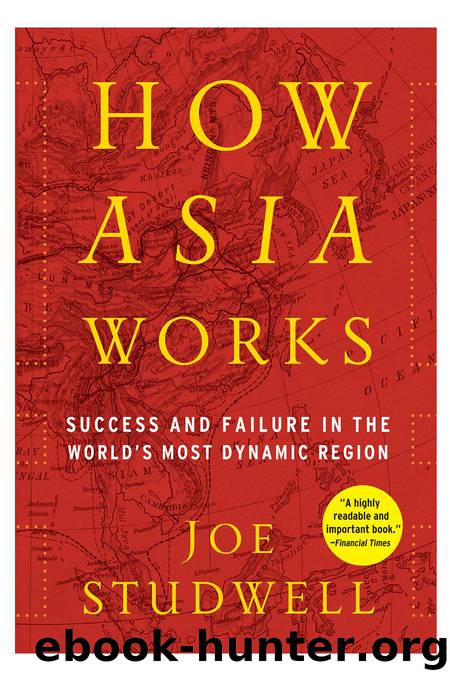How Asia Works: Success and Failure in the World's Most Dynamic Region by Studwell Joe

Author:Studwell, Joe [Studwell, Joe]
Language: eng
Format: mobi
Publisher: Grove/Atlantic, Inc.
Published: 2013-07-01T16:00:00+00:00
Part 4
Where China Fits In
‘The basic point is: we must acknowledge that we are backward, that many of our ways of doing things are inappropriate, and that we need
to change.’
Deng Xiaoping, on being confirmed as China’s
preeminent leader in December 19781
Can the history of east Asian development tell us something useful about the development of the biggest economy in the region, China’s? At a minimum, the wider Asian context helps us frame a useful check-list; more ambitiously, it allows for some tentative projections about China’s future. China can be benchmarked against the three basic structural insights brought about by economic development elsewhere in the region: that a country’s agricultural potential is most quickly released when its farming is transformed into large-scale gardening supported by agricultural extension services; that the technological upgrading of manufacturing is the natural vehicle for swift economic transformation and is achieved by state direction of entrepreneurs towards state-defined industrialisation objectives; and that finance must be harnessed to both these ends, sometimes temporarily sacrificing short-term efficiency considerations for longer-run developmental gains in the form of technological learning.
The victory of the communists in 1949 gave China a revolutionary government that was no less committed to economic modernisation than governments in Japan, Korea and Taiwan. However, for a long time China was constrained because the Communist Party of China (CPC) was captive to the two great socialist fallacies that undid socialist modernisation programmes in other communist states. The first of these was that agriculture could only be efficient at scale, leading to the collectivisation of farming in the mid 1950s. As we saw in part 1, however, agriculture is not like manufacturing, where scale is essential to low unit costs and to the technological learning process that enables firms to produce more sophisticated products. In agriculture, the product never changes – rice is rice and corn is corn. Yields are maximised by the application of fertiliser and more and more labour, which poor countries have in abundance. Premature mechanisation actually reduces yields and leaves rural inhabitants with nothing to do. In east Asia after the Second World War, mechanisation and communist collectivisation in countries including North Korea, China and Vietnam led to hunger and starvation, as it had already done in the Soviet Union.
The second great communist fallacy that China laboured under was – unlike the scale agriculture prejudice, which was shared by many capitalists – a genuinely socialist one. This was that manufacturing could be developed without trade – through a policy of self-sufficiency, or autarky. In essence, this boils down to a country’s people staying home and trying to figure out technological problems on their own. In Asian countries, including China and India, autarky throttled technological development after the Second World War because it removed firms’ capacity to buy, borrow and steal already-developed technologies from elsewhere in the world. Each time firms wanted something new they had to, as the saying goes, reinvent the wheel. The legacy of autarky in China was, by the 1980s, all kinds of passable but hopelessly inefficient industrial processes.
Download
This site does not store any files on its server. We only index and link to content provided by other sites. Please contact the content providers to delete copyright contents if any and email us, we'll remove relevant links or contents immediately.
International Integration of the Brazilian Economy by Elias C. Grivoyannis(70316)
The Radium Girls by Kate Moore(11564)
Turbulence by E. J. Noyes(7660)
Nudge - Improving Decisions about Health, Wealth, and Happiness by Thaler Sunstein(7191)
The Black Swan by Nassim Nicholas Taleb(6720)
Rich Dad Poor Dad by Robert T. Kiyosaki(6109)
Pioneering Portfolio Management by David F. Swensen(6036)
Man-made Catastrophes and Risk Information Concealment by Dmitry Chernov & Didier Sornette(5593)
Zero to One by Peter Thiel(5444)
Secrecy World by Jake Bernstein(4342)
Millionaire: The Philanderer, Gambler, and Duelist Who Invented Modern Finance by Janet Gleeson(4047)
The Age of Surveillance Capitalism by Shoshana Zuboff(3950)
Skin in the Game by Nassim Nicholas Taleb(3941)
The Money Culture by Michael Lewis(3791)
Bullshit Jobs by David Graeber(3788)
Skin in the Game: Hidden Asymmetries in Daily Life by Nassim Nicholas Taleb(3695)
The Dhandho Investor by Mohnish Pabrai(3534)
The Wisdom of Finance by Mihir Desai(3494)
Blockchain Basics by Daniel Drescher(3294)
